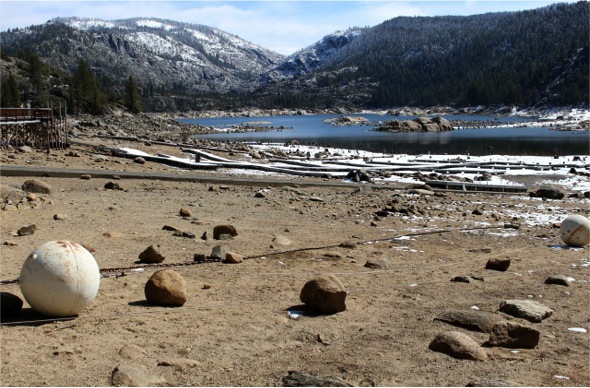 As March came to a close, Pinecrest Lake was slowly inching upward thanks to pulses of rain and snow that soaked forest soils and significantly boosted the minimal flows in mountain streams. The photo shows, however, that the Lake still has a long ways to go if it is to fill and spill in this third straight year of “below normal” precipitation. Besides the well-publicized effects of the drought on agriculture, domestic water supplies, and recreation, the current “critically dry” water year has significant consequences for our mountain ecosystem. Bark beetles are already attacking stressed trees, especially at low elevations. Water-dependent wildlife species that have suffered through two previous dry years now must endure even drier conditions. To attempt to meet the still-high demands for water from Tuolumne Utilities District (TUD) customers, PG&E has shrunk flows in the South Fork Stanislaus to only 1 cubic feet per second below Lyons Reservoir – a tiny flow that you can step across easily. Yet 30 times that amount of water is diverted into the old, leaky ditch system that provides water to TUD customers. Such trade-offs reflect the challenging and politically charged decisions that agencies and politicians face in this extremely dry year. Many Californians are not aware that there have been two drought periods of roughly 200 years in length over the last 1,000 years (based on tree ring and other scientific evidence). How will our forests fare if the current string of three dry years turns into many additional years of drought? Sierra Nevada snowmelt could become truly priceless for both people and nature.
As March came to a close, Pinecrest Lake was slowly inching upward thanks to pulses of rain and snow that soaked forest soils and significantly boosted the minimal flows in mountain streams. The photo shows, however, that the Lake still has a long ways to go if it is to fill and spill in this third straight year of “below normal” precipitation. Besides the well-publicized effects of the drought on agriculture, domestic water supplies, and recreation, the current “critically dry” water year has significant consequences for our mountain ecosystem. Bark beetles are already attacking stressed trees, especially at low elevations. Water-dependent wildlife species that have suffered through two previous dry years now must endure even drier conditions. To attempt to meet the still-high demands for water from Tuolumne Utilities District (TUD) customers, PG&E has shrunk flows in the South Fork Stanislaus to only 1 cubic feet per second below Lyons Reservoir – a tiny flow that you can step across easily. Yet 30 times that amount of water is diverted into the old, leaky ditch system that provides water to TUD customers. Such trade-offs reflect the challenging and politically charged decisions that agencies and politicians face in this extremely dry year. Many Californians are not aware that there have been two drought periods of roughly 200 years in length over the last 1,000 years (based on tree ring and other scientific evidence). How will our forests fare if the current string of three dry years turns into many additional years of drought? Sierra Nevada snowmelt could become truly priceless for both people and nature.

